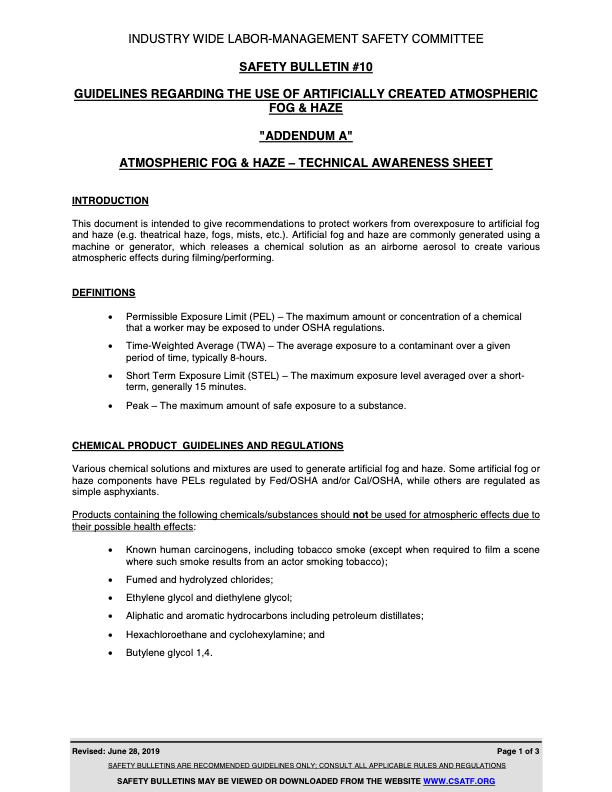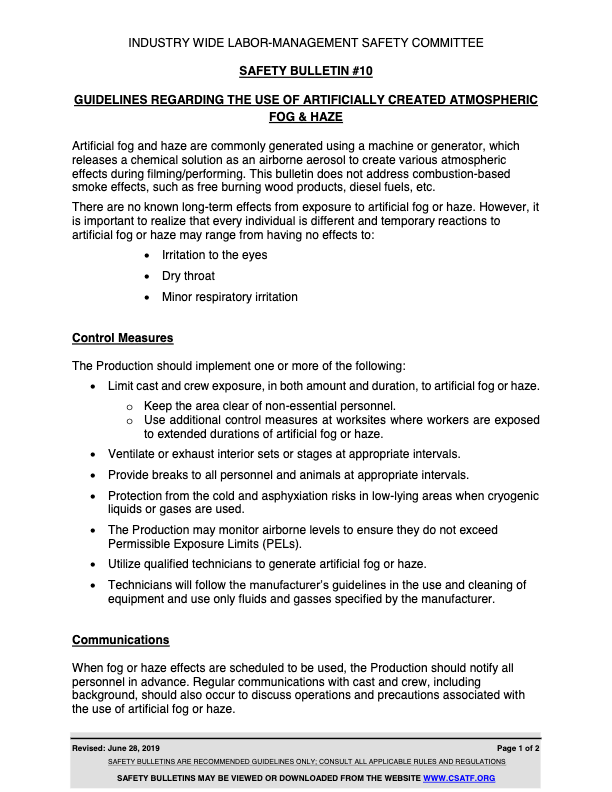Safety Bulletin

Guidelines
This document is intended to give recommendations to protect workers from overexposure to artificial fog and haze (e.g. theatrical haze, fogs, mists, etc.). Artificial fog and haze are commonly generated using a machine or generator, which releases a chemical solution as an airborne aerosol to create various atmospheric effects during filming/performing.
Definitions
- Permissible Exposure Limit (PEL) – The maximum amount or concentration of a chemical that a worker may be exposed to under OSHA regulations.
- Time-Weighted Average (TWA) – The average exposure to a contaminant over a given period of time, typically 8-hours.
- Short Term Exposure Limit (STEL) – The maximum exposure level averaged over a short- term, generally 15 minutes.
- Peak – The maximum amount of safe exposure to a substance.
CHEMICAL PRODUCT GUIDELINES AND REGULATIONS
Various chemical solutions and mixtures are used to generate artificial fog and haze. Some artificial fog or haze components have PELs regulated by Fed/OSHA and/or Cal/OSHA, while others are regulated as simple asphyxiants.
Products containing the following chemicals/substances should not be used for atmospheric effects due to their possible health effects:
- Known human carcinogens, including tobacco smoke (except when required to film a scene where such smoke results from an actor smoking tobacco);
- Fumed and hydrolyzed chlorides;
- Ethylene glycol and diethylene glycol;
- Aliphatic and aromatic hydrocarbons including petroleum distillates;
- Hexachloroethane and cyclohexylamine; and
- Butylene glycol 1,4.
The following substances may be used:
- Propylene glycol, butylene glycol (1,2 & 1,3), polyethylene glycol, triethylene glycol, and dipropylene glycol;
- Glycerin products;
- Caution: Glycerin and the listed glycol products should not be heated beyond the minimum temperature necessary to aerosolize the fluid. In no event should glycerin or glycol be heated above 700 degrees Fahrenheit.
- Mineral oils (highly refined only); and
- Cryogenic liquids and gases (e.g., carbon dioxide (dry-ice), liquid nitrogen) may be used, but care must be exercised to avoid depleting oxygen levels, especially in confined or low- lying areas. When used, adequate fresh air should be supplied to avoid creating a hazardous atmosphere that may result in asphyxiation. Careless handling of liquid nitrogen may result in cold burns. Use caution to avoid the adverse effects of cryogenic materials on exposed persons.
- When using asphyxiants, including cryogenic liquids and steam, in confined spaces, monitor the oxygen level. Oxygen levels should stay between 19.5% and 22%.
- When using asphyxiants, including cryogenic liquids and steam, in confined spaces, monitor the oxygen level. Oxygen levels should stay between 19.5% and 22%.
Airborne Permissible Exposure Limits, as specified in the table below, should not be exceeded unless control measures are in place.
| Ingredient | Fed OSHA 8-hour Time Weighted Average (mg/m³) | Short Term Exposure Limit (STEL) (mg/m³) | Peak (mg/m³) |
|---|---|---|---|
| Glycerin Mist (total dust) | 15 | – | 50 |
| Glycerin Mist (respirable fraction) | 5 | – | 50 |
| Glycol | 10 | 40 | 40 |
| Mineral Oil | 5 | 10 | 25 |
Refer to Fed/OSHA and Cal/OSHA Regulations for further information and/or requirements.
CONTROL MEASURES
The following control measures should be performed or implemented when using artificial fog or haze:
- Eliminate the need for artificial fog or haze whenever possible.
- Limit the cast and crew exposure to artificial fog or haze. Keep the area clear of non-essential personnel.
- Use the minimum concentration necessary to achieve the desired effect.
- Ventilate or exhaust interior sets or stages at appropriate intervals.
- Provide breaks away from the set or stage to personnel and animals at appropriate intervals.
- Attach Industry Wide Labor-Management Safety Committee Safety Bulletin #10 “Guidelines Regarding the Use of Artificially Created Atmospheric Fog & Haze” to the call sheet whenever artificial fog or haze is scheduled to be used that day.
- The Production may monitor airborne levels to ensure that they do not exceed Permissible Exposure Limits.
- If airborne levels are anticipated to exceed PELs, appropriate respiratory protection must be provided. Contact your studio safety representative for guidance.
- Ensure that Safety Data Sheets (SDSs) are made readily available.
- If an infant is present on a Production, take the appropriate steps to prevent that infant from being exposed to artificial fog or haze.
- Consult Safety Bulletin #33, “Special Safety Considerations When Employing Infant Actors (Fifteen Days to Six Months Old)”.
- Ensure that qualified technicians are utilized to generate artificial fog or haze.
- Technicians should follow manufacturer’s guidelines for the use and cleaning of equipment and only use fluids and gasses specified by the manufacturer.
MEASURING AIRBORNE CONCENTRATIONS
Airborne concentrations can be measured using a variety of instruments and by following recognized monitoring methods:
- Various direct-reading instruments that measure airborne aerosol are available for rent or purchase.
- Qualitative and quantitative testing should be conducted by or under the direction of an individual who is knowledgeable about the testing process. A correction factor, which varies with the reading instrument used, the type of fluid used, and the type of machine, must be applied. An industrial hygienist or qualified person can be contacted to discuss measuring airborne concentrations including correction factors and testing.
- If airborne monitoring has not been conducted, then ensure that exposure estimates (based on previous monitoring reports, available literature, or professional health and safety advice) are available.
EXTENDED EXPOSURE
Consider extended work shifts and the consequences of working more than 8 hours per shift, as it relates to time-weighted average (TWA). As exposure time increases, the Permissible Exposure Limit decreases.
Adjust exposure limits for extended work shifts (longer than 8-hours), as follows. Decrease the noted 8- hour TWA PEL by a factor of (8/extended shift length):
- 10 hour adjusted TWA = (8/10) x 10 mg/m3 = 8.0 mg/m3
- 12 hour adjusted TWA = (8/12) x 10 mg/m3 = 6.7 mg/m3
- 14 hour adjusted TWA = (8/14) x 10 mg/m3 = 5.7 mg/m3
For questions on artificial fog or haze, please contact your studio safety representative. Please refer to the Studio Safety Hotlines document for guidance on how to contact the appropriate safety representative.

